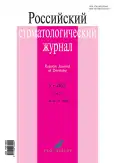Long-term results of the restoration of the mobility of the mandible after fractures and prolonged immobilization
- Authors: Valieva L.U.1, Pankratov A.S.1,2, Ivanov S.Y.1,3, Khandzratsyan A.S.4, Kogay V.V.4
-
Affiliations:
- Sechenov First Moscow State Medical University (Sechenov University)
- Russian Medical Academy of Continuous Professional Education
- Peoples’ Friendship University of Russia
- Inozemtsev City Clinical Hospital No. 36
- Issue: Vol 26, No 5 (2022)
- Pages: 389-396
- Section: Clinical Investigation
- URL: https://journals.rcsi.science/1728-2802/article/view/232563
- DOI: https://doi.org/10.17816/dent110959
- ID: 232563
Cite item
Abstract
BACKGROUND: Fractures of the lower jaw accounts for up to 85% of the total number of fractures of the facial bones. Its damage leads to the formation of temporary and persistent functional disorders of the stomatognathic apparatus. Understanding the regularities of the processes of restoring the motor functions of the mandible and chewing apparatus is necessary for planning and improving rehabilitation programs in these patients.
AIM: To examine the degree and rate of restoration of the amplitude of movements of the mandible in the long-term period of the rehabilitation stage of patients with mandibular fractures.
MATERIAL AND METHODS: A prospective study was conducted on 40 patients with unilateral and bilateral mandibular fractures, who made up two groups depending on the volume of treatment according to current clinical protocols: group 1 included 22 people who underwent double-jaw splinting during treatment, and group 2 included 18 people who, according to indications, also underwent osteosynthesis of the mandible with subsequent intermaxillary immobilization in the postoperative period. One year after the removal of splinting structures, all mobile patients underwent a clinical assessment of the range of motions of the lower jaw.
RESULTS: Even 1 year after the successful treatment of patients in the acute period of trauma, despite the implementation of myogymnastics in the rehabilitation period, the range of motions of the lower jaw remains limited. In group 1, after 1 year of observations, the average values correspond to the lower limits of the norms according to literature data: opening, 4.35 cm; with protrusion, 0.78 cm; laterotrusion with unilateral fractures in the damaged side, 0.95 cm; intact, 0.91; bilateral, the damaged side 1 (right), 0.86 cm, damaged side 2 (left), 0.86 cm. In group 2, during the observation period, these indicators remained significantly lower, not reaching the limits of the norm in any case. Moreover, in both groups, their values were significantly lower than those of the healthy volunteers
CONCLUSIONS: Data obtained on the patterns of restoration of the range of motion of the lower jaw after sustaining a fracture and prolonged immobilization in the long-term justify the need to develop and conduct mandatory early comprehensive rehabilitation measures. Their clinical effectiveness should be confirmed from the standpoint of evidence-based medicine, which enables the comprehensive assessment of the function of the stomatognathic apparatus. This study established indicators that can be considered control criteria when performing relevant studies.
Full Text
##article.viewOnOriginalSite##About the authors
Leyli U. Valieva
Sechenov First Moscow State Medical University (Sechenov University)
Author for correspondence.
Email: leyka3@yandex.ru
ORCID iD: 0000-0002-3990-3843
Postgraduate Student
Russian Federation, MoscowAlexander S. Pankratov
Sechenov First Moscow State Medical University (Sechenov University); Russian Medical Academy of Continuous Professional Education
Email: stomat-2008@mail.ru
ORCID iD: 0000-0001-9620-3547
SPIN-code: 9785-2632
Russian Federation, Moscow; Moscow
Sergey Yu. Ivanov
Sechenov First Moscow State Medical University (Sechenov University); Peoples’ Friendship University of Russia
Email: edu@dr-ivanov.ru
ORCID iD: 0000-0001-5458-0192
MD, Dr. Sci. (Med.), Professor
Russian Federation, Moscow; MoscowAra S. Khandzratsyan
Inozemtsev City Clinical Hospital No. 36
Email: dr.khandzratsyn@mail.ru
ORCID iD: 0000-0003-3959-2050
MD, Cand. Sci. (Med.)
Russian Federation, MoscowVladimir V. Kogay
Inozemtsev City Clinical Hospital No. 36
Email: kogay_vlad@list.ru
ORCID iD: 0000-0003-1482-808X
Russian Federation, Moscow
References
- Lalloo R, Lucchesi LR, Bisignano C, et al. Epidemiology of facial fractures: incidence, prevalence and years lived with disability estimates from the Global Burden of Disease 2017 study. Inj Prev. 2020;26(Suppl. 1):i27-i35. doi: 10.1136/injuryprev-2019-043297
- Xiao-Dong L, Qiu-Xu W, Wei-Xian L. Epidemiological pattern of maxillofacial fractures in northern China: A retrospective study of 829 cases. Medicine (Baltimore). 2020;99(9):e19299. doi: 10.1097/MD.0000000000019299
- Shah N, Patel S, Sood R, et al. Analysis of Mandibular Fractures: A 7-year Retrospective Study. Ann Maxillofac Surg. 2019;9(2):349–354. doi: 10.4103/ams.ams_22_19
- Wusiman P, Maimaitituerxun B, Guli, et al. Epidemiology and Pattern of Oral and Maxillofacial Trauma. J Craniofac Surg. 2020;31(5):e517–e520. doi: 10.1097/SCS.0000000000006719
- Amarista Rojas FJ, Bordoy Soto MA, Cachazo M, et al. The epidemiology of mandibular fractures in Caracas, Venezuela: Incidence and its combination patterns. Dent Traumatol. 2017;33(6):427–432. doi: 10.1111/edt.12370
- Saman M, Kadakia S, Ducic Y. Postoperative maxillomandibular fixation after open reduction of mandible fractures. JAMA Facial Plast Surg. 2014;16(6):410–413. doi: 10.1001/jamafacial.2014.543
- Rajantie H, Snäll J, Thorén H. Temporomandibular Dysfunction After Surgery of Mandibular Fractures Not Involving the Mandibular Condyle: A Prospective Follow-Up Study. J Oral Maxillofac Surg. 2019;77(8):1657–1662. doi: 10.1016/j.joms.2019.03.034
- Mingazova LR, Orlova OR. Myofascial facial pain syndrome: clinic, diagnosis and treatment using botulinum toxin type A (Lantox®). Effective Pharmacotherapy: Neurology and Psychiatry. 2010;(15):36–43. (In Russ).
- Da Silva AP, Sassi FC, Bastos E, et al. Oral motor and electromyographic characterization of adults with facial fractures: a comparison between different fracture severities. Clinics (Sao Paulo). 2017;72(5):276–283. doi: 10.6061/clinics/2017(05)04
- Borba AM, Porto AN, Santini A, et al. The effect of facial fractures on mouth opening range: a case series. RSBO. 2017;14(3):142–146. doi: 10.21726/rsbo.v1i3.483
- Nussbaum BL. Dental care for patients who are unable to open their mouths. Dent Clin North Am. 2009;53(2):323–328. doi: 10.1016/j.cden.2008.12.006
- Bairikov IM, Saveliev AL. Fracture of the lower jaw: clinical guidelines. Moscow; 2016. 42 p. (In Russ).
- Kulakov AA, Drobyshev AYu, Yaremenko AI, et al. Fracture of the lower jaw: clinical guidelines. Moscow; 2021. 55 p. (In Russ).
- Celić R, Jerolimov V, Knezović Zlatarić D, Klaić B. Measurement of mandibular movements in patients with temporomandibular disorders and in asymptomatic subjects. Coll Antropol. 2003;27(Suppl. 2):43–49.
Supplementary files










